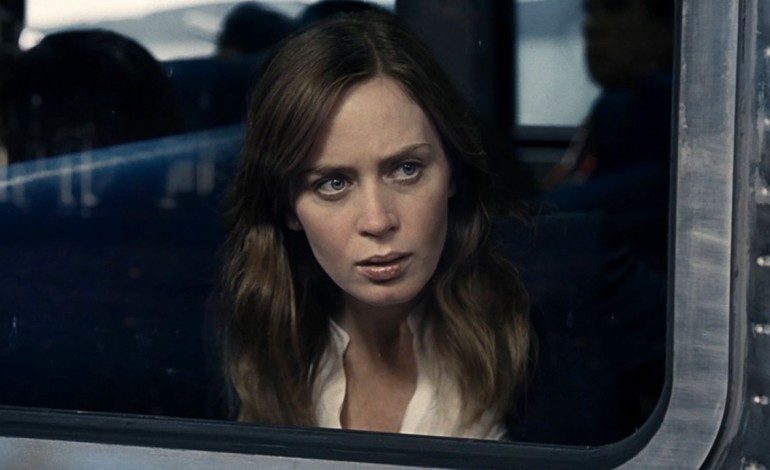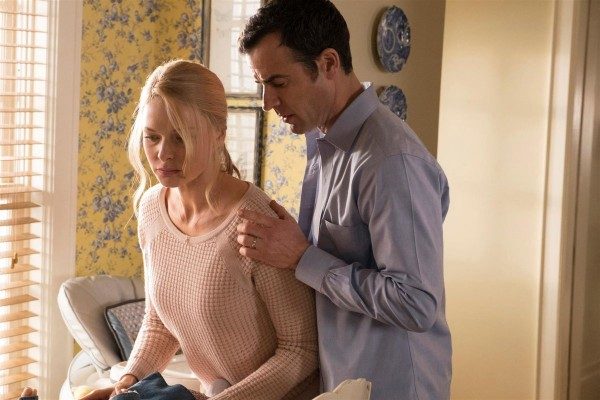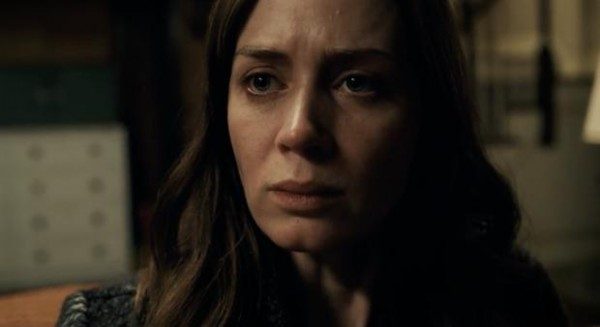

There are two warring opposites at play in Tate Taylor’s (The Help) adaptation of The Girl on the Train: one is Taylor and starring actress Emily Blunt’s bountiful talent and vision, and the other is a messy and problematic story that has a difficult time catching up to its creative visionaries. By way of entertainment value and ability to captivate, the film will likely live up to the success of its bestselling novel. There is plenty of sex, intrigue, meme-able drinking scenes, and edge-of-your-seat antics that will bring in audiences for a relatively enjoyable experience. Taylor and Blunt, though, are forced to make lemonade from lemons with a story steeped in troubling gender dynamics and melodramatic characters that ultimately pales in comparison to Blunt’s magnificently turbulent performance.
Based on Paula Hawkins’ 2015 novel and adapted for the screen by Erin Cressida Wilson (Chloe), The Girl on the Train follows Rachel (Blunt), an alcoholic divorcée who spends her days living vicariously through a couple (Haley Bennett, Luke Evans) she watches out the window on her train route. To her, this couple represents true love and everything she has lost, including Tom, her cheating ex-husband (Justin Theroux) who lives two doors down from the couple with his new wife and baby. Rachel obsesses over the couple and experiences personal betrayal all over again when she learns that their marriage may be anything other than perfect. Known to suffer from drunken blackouts, Rachel wakes up one morning with blood on her face, bruises on her body, and the news that Megan, one half of the perfect couple, has gone missing. Rachel finds herself to be a major suspect in the case, forcing her to face her personal demons in order to find out the truth.
The premise of The Girl on the Train sounds like delightful feminist fodder on the surface – a thrilling murder mystery featuring three starring roles for women, a female protagonist with a rich and flawed backstory, as well as what could be a refreshing study on the female gaze. Somewhere along the way, however, these lofty promises take a nosedive. The female gaze is somewhat corrupted through Rachel’s hazy unreliable perspective, which would be fine if she were able to take back control of the narrative in a satisfying way. Although it is up to her to ultimately solve the film’s mystery, the male gaze overpowers for the majority of the film. Filtered in and out between scenes told through Rachel’s eyes are scenes featuring the perspective of an omniscient narrator that favors a dominant male slant, cutting down the female characters as being overly sexual, jealous, or erratic.
Unfortunately, the story’s mystery relies on the audience’s mistrust of its female characters. While it does lead to a somewhat clever twist, that mistrust digs the women an insidious hole and results in a soap opera-esque villain (without giving too much away). In the same vein that the plot fails its women, The Girl on the Train also perpetuates male cliches based in stereotypical masculine traits like violence and sex. Every man seems to be getting laid at will while the women are either used for sex or are left with their desires unfulfilled. The film does stress that these women are sexual beings and doesn’t shame them for it, but does measure their value based on their birthing ability or desire for procreation.
With enormous potential for quality female storytelling, the film does kick off brilliantly. Taylor’s visuals are immediately arresting and Rachel’s perspective gives audiences a highly unexplored view into female desire. Taylor gives Rachel’s hazy vision a visual complement, using inventive reflective techniques, mirroring, and mood lighting to base her gaze in a trance-like state, making it just as difficult for the audience to decipher between Rachel’s projected desires and her somber reality. Rachel is also an undoubtedly compelling character to carry the story. Her “overactive imagination”, as her ex puts it, takes the film in exciting and suspenseful directions, and finds another narrative outlet through Rachel’s disturbed journal illustrations.
Blunt’s unhinged performance as Rachel also brings the character to an enhanced level, finding moments to translate her derangement and wounded insecurity through Black Swan quality levels. Taking on a character completely lost in depression and alcoholic stupor, Blunt never allows Rachel to lose her sense of personhood. She instead plays out Rachel’s identity crisis within the confines of her disjointed, yet vibrant, inner world – one filled with desire, passion, creativity, and a drive to repair her ability for human connection. One particular bathroom scene showcases Blunt’s intricate portrayal – after speaking in the mirror to herself like a woman possessed, she subsequently gives herself a quick and humorously common balance check before heading out the door.
Her female counterparts – the projected dream wife Megan, and her ex’s new wife Anna (Rebecca Ferguson) – aren’t given as much to work with, though. Trapped in either the male gaze, or the desire of Rachel’s perspective, their characters are given very little agency. Megan at one point sexually teases her therapist (Edgar Ramirez), and he puts it perfectly when he says that she is “only pretending”, that her supposed sexual freedom is possibly an act or diversion for the brokenness within. Likewise, Anna is defined by her adulterating and the fear of losing the temporary power of her sexual potency over Tom. This sheds terrible light on the fact that Rachel, a woman deprived of her sexual desire, is ultimately given the most power to enact change in the film.
Verdict: 3 out of 5
If you are someone who can look past the film’s twisted web of sketchy gender politics, you may find yourself genuinely enjoying The Girl on the Train beyond its capacity for guilty pleasure. If anything, the film is surely a suspenseful thrill until Rachel begins to truly put the pieces back together, at which point the film loses a lot of steam and peters out for the final twenty or so minutes. Taylor wholly delivers with visual intrigue, though, and Blunt more than delivers in her performance. But ultimately, the two are far more talented and capable than the story they are telling.



